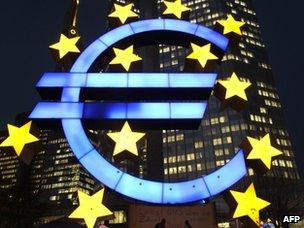The rising costs of eurozone rescues
- Published
- comments

The eurozone has two bailout funds of any size at all: the European Financial Stability Facility, which exists now, and the European Stability Mechanism, which is supposed to be launched in July.
They exist (mainly) to lend to governments deemed to be solvent but which can't borrow from investors.
Even before Friday's downgrades by Standard & Poor's of nine eurozone governments, there were already concerns that the bailout funds' resources were inadequate to rescue a state with huge debts, such as Italy.
So a particularly damaging consequence of S&P's decision to strip Austria and France of their AAA ratings is that the two bailout funds will have even less to lend, if the funds themselves want to retain their own AAA ratings.
The reason (slightly simplifying) is that any lending by the bailout funds is backed by eurozone countries - and if fewer eurozone countries have a AAA badge, then a much smaller amount of lending by those funds would be underpinned by support from AAA governments.
That is one reason why the Chancellor, George Osborne, is concerned that eurozone countries aren't doing enough to prevent a breakup of their currency union. This is what he told the Today Programme this morning:
"I think what the euro needs to do is show convincingly that it can stand behind its currency. We haven't actually seen much evidence of the pooled resources needed by the euro to actually provide confidence to the market that they will stand by their own currency."
Eurozone leaders face a tricky choice.
They can abandon the idea that the bailout funds need a AAA rating. The German chancellor Angela Merkel suggested over the weekend that this may be the better way to proceed.
But were the bailout funds to go AA or AA plus, the costs for the bailout funds of borrowing would probably rise.
And the funds might have difficulty raising money from some high profile investors, such as China, whose participation would have huge symbolic value.
The alternative of asking eurozone governments to increase their financial backing for the funds to sustain both their AAA and their lending capacity would however place quite a strain on the balance sheets of eurozone governments, especially that of Europe's biggest economy, Germany.
According to new research by Royal Bank of Scotland, if eurozone leaders wanted to do what Mr Osborne implies they should do and double the lending capacity of the European Stability Mechanism from what it was prior to the S&P downgrade, eurozone countries would have to provide capital equivalent to 2.6 trillion euros, or 27% of euro area GDP.
All of which is a long-winded way of saying that the downgrades of France and Austria have dealt a hefty blow to the eurozone's ambitions of establishing bailout funds with sufficient liquid resources to douse whatever fires erupt in the currency union.
And that matters more than ever, with Greece teetering on the brink of default because of an impasse in debt-reduction talks between the Greek government and its private-sector creditors.
If Greece were to default, investors would only be persuadable that Portugal, Ireland and even Italy and Spain won't be next in the queue to renege on what they owe, if the two bailout funds have access to an ocean of emergency money.
Following the S&P downgrades, the bailout funds are endowed with what looks like a puddle or pond, rather than a great sea of money stretching beyond the horizon.
UPDATE 18:48
S&P has tonight downgraded the European Financial Stability Facility, Europe's rescue fund, by one notch to AA plus from AAA.
It warned there could be further downgrades if the finances of eurozone members were to weaken further.
Eurozone members now have to decide whether to reconstruct the bailout fund to restore the AAA or whether to take the downgrade on the chin, with the possible consequences I mentioned earlier.